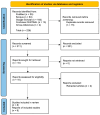The Evidence for Perioperative Anesthetic Techniques in the Prevention of New-Onset or Recurrent Complex Regional Pain Syndrome in Hand Surgery
- PMID: 39202016
- PMCID: PMC11355343
- DOI: 10.3390/jpm14080825
The Evidence for Perioperative Anesthetic Techniques in the Prevention of New-Onset or Recurrent Complex Regional Pain Syndrome in Hand Surgery
Abstract
Complex regional pain syndrome (CRPS) is a multifaceted condition characterized by chronic neuropathic pain, allodynia, and hyperalgesia. The incidence of CRPS postoperatively is alarmingly high, particularly following carpal tunnel surgeries, Dupuytren's fasciectomy, and repairs of wrist and hand fractures, with recurrence rates soaring in individuals with a history of CRPS. Despite extensive research, the management of CRPS remains complicated, highlighting the urgent need for effective prevention strategies. This scoping review aimed to consolidate current evidence surrounding the efficacy of perioperative anesthetic techniques in preventing new-onset or recurrent CRPS, focusing on the application of various anesthetic interventions. Through a comprehensive literature search, eight articles were identified, discussing a spectrum of techniques, including wide awake local anesthesia no tourniquet (WALANT) and various regional blockade methods. This review revealed that the WALANT technique, with its simplicity and lower costs, exhibited promising results in preventing CRPS. Conversely, techniques involving intravenous regional and axillary plexus blocks showed variable efficacy, necessitating further investigation. The scarcity of high-quality evidence underscores the critical need for meticulously designed, large-scale randomized controlled trials to validate these findings and explore the potential of stellate ganglion block in the prevention of recurrent CRPS.
Keywords: hand; nerve; pain; patient outcomes; plastic surgery; trauma.
Conflict of interest statement
The authors declare no conflicts of interest.
Figures
References
-
- Ferraro M.C., Cashin A.G., Wand B.M., Smart K.M., Berryman C., Marston L., Moseley G.L., McAuley J.H., O’Connell N.E. Interventions for treating pain and disability in adults with complex regional pain syndrome—An overview of systematic reviews. Cochrane Database Syst. Rev. 2023;6 doi: 10.1002/14651858.CD009416.pub3. - DOI - PMC - PubMed
-
- Harden N.R., Bruehl S., Perez R., Birklein F., Marinus J., Maihofner C., Lubenow T., Buvanendran A., Mackey S., Graciosa J., et al. Validation of proposed diagnostic criteria (the “Budapest Criteria”) for Complex Regional Pain Syndrome. Pain. 2010;150:268–274. doi: 10.1016/j.pain.2010.04.030. - DOI - PMC - PubMed
Publication types
LinkOut - more resources
Full Text Sources


